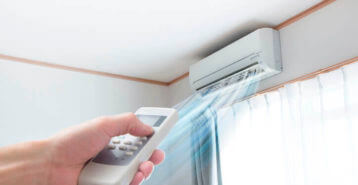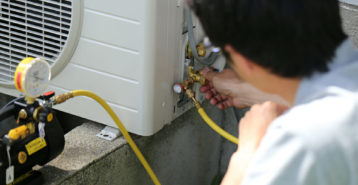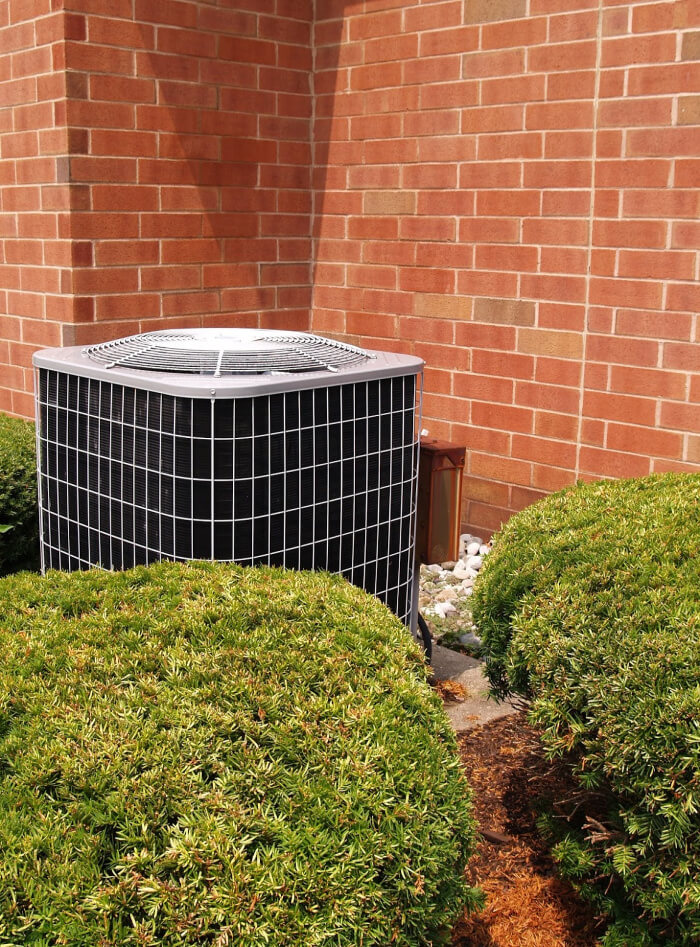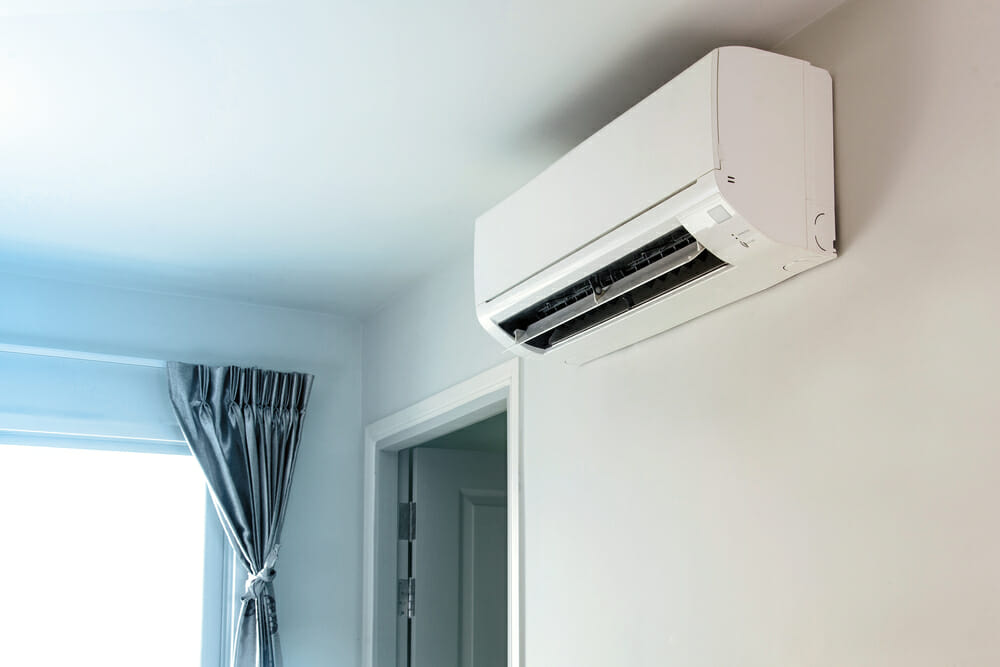What Are Ductless Air Conditioners?
If you’re looking for a flexible, energy-efficient way to heat and cool your home without the need for traditional ductwork, a ductless air conditioner could be the perfect solution. These systems are designed to provide zoned comfort, letting you control the temperature in individual rooms while saving on energy costs. In this guide, we’ll break down how ductless systems work, what they cost, the different types available, and whether one might be the right fit for your home.

How Do Ductless Air Conditioners Work?
Ductless air conditioners work by moving heat rather than generating it, making them an efficient option for heating and cooling. Each system includes two main components: an outdoor compressor and one or more indoor air-handling units. These are connected by a small conduit that houses the refrigerant tubing, electrical wiring, drain line, and power cable.
The process starts when the indoor unit pulls warm air from the room. The refrigerant absorbs the heat and carries it to the outdoor unit, releasing it outside. Cooled refrigerant then cycles back indoors, and the air handler blows cool air into the room using a quiet fan. In heating mode, the process is reversed to bring warm air inside.
Each indoor unit has its own thermostat, allowing you to customize the temperature in different areas of your home. This zoned cooling means you only use energy where and when you need it, boosting overall efficiency.
Ductless Air Conditioner Installation
Installing a ductless air conditioner should always be done by a certified HVAC professional. The process includes placing the outdoor compressor, mounting the indoor air handlers, and connecting everything with refrigerant lines, electrical wiring, and a condensate drain. When installed properly, your system runs safely and reliably.
There are two main types of ductless AC systems: mini split and multi split.
Mini Split Systems
Mini split systems are ideal for heating or cooling a single room or zone. They include three main components:
- An outdoor compressor
- An indoor air handler
- A remote control or thermostat
The indoor and outdoor units are connected by copper tubing that circulates refrigerant. A drain line removes moisture created during operation. You can place these units up to 50 feet apart, offering flexible installation options.
Multi Split Systems
Multi split systems connect one outdoor compressor to multiple indoor units, often up to five. The contractor will install each air handler in a separate room, where the unit works independently, allowing you to set different temperatures in each space. This setup requires more tubing and wiring but offers customized comfort throughout the home.
Choosing Between Mini Split and Multi Split
Both systems use the same basic technology, but they serve different needs. A mini split is great for single-room control with one temperature setting. A multi split allows for individual climate control in multiple rooms, making it ideal for larger homes or families with different comfort preferences.
If you’re upgrading your HVAC system or adding air conditioning to a specific area, ductless systems offer an efficient, low-impact solution with the flexibility to match your home’s layout.
Ductless Air Conditioner Installation Cost
The cost to install a ductless air conditioner typically ranges from $2,100 to $3,900, depending on the size of your system and the number of zones you need to cool or heat. For example, a single-zone 18,000 BTU unit with a 21 SEER rating — ideal for a 350 sq. ft. room — costs about $1,500 for the unit alone and around $3,800 with professional installation.
Here’s a general idea of how costs increase as you add more zones:
- One unit: $1,500 to $2,000
- Two units: $2,000 to $3,500
- Three units: $3,000 to $4,300
- Four or more units: $4,500+
Multi-zone systems tend to be more expensive because each indoor unit requires separate wiring and refrigerant lines. However, they offer the benefit of independent temperature control in multiple rooms.
Factors That Affect Ductless AC Costs
- System Size and Number of Zones: Larger systems with more indoor air handlers cost more. Each additional unit adds to both equipment and labor costs.
- Labor and Installation: Professional HVAC installation typically costs between $1,300 and $2,000. This includes placing the outdoor condenser, cutting access holes, running electrical and refrigerant lines, and setting up a drainage system.
- Home Layout: Older homes or those without easy access to electrical points may need additional upgrades, which can increase overall installation costs.
- Contractor Experience: Ductless systems require specialized knowledge. Choosing an experienced contractor, even if they cost more, helps ensure the system is installed correctly and performs efficiently.
- Mini Split vs. Multi Split: Mini split systems are usually less expensive than multi split systems. Multi split setups require more materials and labor since each indoor unit connects independently to the outdoor compressor.
What Size Ductless AC Unit Do I Need?
Choosing the right size ductless AC unit is essential for efficient heating and cooling. If your system is too small, it won’t keep up on extreme temperature days. If it’s too large, it may short cycle (turn off and back on frequently) which reduces efficiency and comfort.
To determine the best size, match the BTU rating of the unit to the square footage of the space you want to heat or cool. For example, a 400-square-foot room typically requires a 9,000 BTU unit. Larger areas will need more powerful units, while smaller rooms can be handled by lower BTU systems.
Use the chart below to estimate the right BTU rating for your space:
| Ductless Heat Pump BTUs Needed | Room Square Ft. |
|---|---|
| 6,000 BTUs | 150 to 250 sf. |
| 7,000 BTUs | 250 to 300 sf. |
| 8,000 BTUs | 300 to 350 sf. |
| 9,000 BTUs | 350 to 400 sf. |
| 10,000 BTUs | 400 to 450 sf. |
| 12,000 BTUs | 450 to 550 sf. |
| 14,000 BTUs | 550 to 700 sf. |
| 18,000 BTUs | 700 to 1,000 sf. |
| 21,000 BTUs | 1,000 to 1,200 sf. |
| 23,000 BTUs | 1,200 to 1,400 sf. |
| 24,000 BTUs | 1,500 sf. + |
Single Zone vs. Multi Zone Installation
When choosing a ductless AC system, you’ll need to decide between single-zone and multi-zone setups. The right option depends on your home’s layout, how you use each room, and your budget.
| System Type | Components | Where to Use |
|---|---|---|
| Single-Zone | One outdoor unit One indoor air handler One temperature setting | Single rooms or open-concept spaces Home additions or garages Areas that need extra heating or cooling |
| Multi-Zone | One outdoor unit Up to five indoor units Each with its own thermostat | Homes with multiple rooms needing independent temperature control Families with different comfort preferences Whole-home heating and cooling without ductwork |
Key Differences
- Cost: Multi-zone systems are more expensive to install due to added materials and labor.
- Control: Single-zone systems control one area, while multi-zone systems offer room-by-room comfort.
- Efficiency: Both systems are energy efficient, but multi-zone systems let you avoid wasting energy in unused rooms.
Choose based on how many rooms you need to control and how much flexibility you want in your home’s temperature settings.
Is Ductless AC Cheaper than Central AC?
One of the biggest advantages of a ductless AC system is the potential for cost savings, both upfront and long-term. Central air conditioning systems rely on ductwork to distribute cooled air throughout the home. But that ductwork often leads to energy loss. As air travels through ducts — especially those running through unconditioned spaces like attics or crawlspaces — it can lose a lot of its cooling power. Even with heavy insulation, ducts allow some of that energy to escape.
Ductless AC systems avoid this issue entirely. Because there are no ducts, the cooled air is delivered directly into the room where it’s needed. There’s no energy loss between the system and your living space. That direct delivery leads to better efficiency and can result in lower energy bills over time.
Another major benefit? Zoned control. Each ductless unit has its own thermostat, so you can set different temperatures in different rooms. That means no wasted energy cooling rooms you’re not using, just personalized comfort wherever you need it.
Ductless Air Conditioner vs. Central AC
- Lower Installation Costs: Without ductwork, the installation is faster and generally more affordable than central systems.
- Less Disruption to Your Home: Since no ducts are needed, there’s no need to tear into walls or ceilings.
- Flexible Installation Options: Indoor units can be mounted on walls, recessed into ceilings, or flush-mounted depending on your space and design preferences.
- Stylish and Discreet Units: Manufacturers offer ductless systems in a variety of colors and finishes to help them blend in with your décor.
- Multi-Zone Options: A single outdoor unit can connect to multiple indoor units, each with its own thermostat for room-by-room temperature control.
- More Living Space: No ducts means more ceiling height or closet space in areas that would otherwise hide ductwork.
Choosing a Ductless Air Conditioner
If you’re shopping for a ductless system, here’s what to look for to ensure the best performance and energy savings:
- ENERGY STAR® Certification: These systems meet high-efficiency standards set by the EPA and DOE.
- High SEER and EER Ratings: The higher the rating, the more energy-efficient the unit. While these systems may cost more upfront, they typically save more over time.
- Proper BTU Sizing: Make sure you match the unit’s BTU capacity to your room size. Too big or too small, and you won’t get the efficiency or comfort you’re paying for.
Ductless air conditioner systems offer a smart, efficient alternative to traditional central air. This is especially true for homes without existing ductwork, or anyone looking to cut down on energy bills.
Benefits of Ductless Air Conditioning
Ductless AC systems offer a range of advantages that make them a smart choice for many homeowners. Here are some key benefits to consider:
- Zone-Specific Comfort: If your home uses wall units, baseboard heaters, or radiant heating, you can add a ductless system to cool just one area, like a living room or primary bedroom, without needing to convert your entire home.
- Energy Efficiency of Ductless Air Conditioners: Manufacturers design these systems for high performance and minimal energy waste. Because they deliver cooled or heated air directly to the room, there’s no energy loss through ductwork.
- Lower Installation Costs: Since there’s no need to install or modify ductwork, ductless air conditioning is often faster and cheaper to install than central HVAC systems.
- Quiet Operation: Ductless units are designed to run quietly, making them ideal for bedrooms, home offices, and other spaces where noise is a disruption.
- Custom Temperature Control: Multi-zone systems allow for individual temperature settings in different rooms, which means no more fighting over the thermostat.
- Tax Credits and Rebates: Many ductless systems qualify for local, state, or federal energy efficiency incentives. Be sure to check what rebates or tax credits are available in your area before you commit to an installation.
- Flexible Design Options: Indoor units come in various styles and finishes and can be mounted on the wall, ceiling, or recessed for a more discreet look.
- Improved Air Quality: Ductless systems have built-in filtration that captures dust, allergens, and other particles, helping to improve indoor air quality with less maintenance than ducted systems.

What Are the Disadvantages of Ductless Air Conditioning?
While ductless AC systems offer flexibility and energy savings, they may not be the perfect solution for every home. Here are a few potential drawbacks to keep in mind:
- Limited Cold Weather Performance: Ductless systems typically provide heating in temperatures as low as 5°F, and only a few models can function down to -15°F. In areas with freezing winters, you may need a backup heat source.
- Challenged by Extreme Heat: If you live in a region with extremely hot summers, a ductless air conditioner may not be powerful enough to cool your entire home on its own. You might need to supplement it with a central HVAC system.
- Higher Upfront Cost: Ductless systems, especially multi-zone setups, can cost more upfront than window units or traditional HVAC systems.
- Visible Indoor Units: Indoor air handlers are mounted on walls or ceilings and remain visible in the room.
- Installation Complexity: Proper installation requires a certified HVAC contractor. Your installer will run electrical and refrigerant lines, drill through walls, and set up proper drainage for condensation.
Finding a Ductless AC Installer
Choosing the right professional is just as important as choosing the right ductless air conditioner system. To protect your investment, always work with a licensed HVAC contractor who specializes in ductless air conditioning. A qualified installer will help you select the right system size, determine the best placement for indoor and outdoor units, and ensure your setup is tailored to your home’s layout and comfort needs.
Before you hire a contractor, follow these steps:
- Request a Written Estimate: Get a detailed quote that includes labor, materials, and any potential extras. This helps avoid surprise costs down the line.
- Verify Licenses and Insurance: Make sure the contractor has a valid HVAC license as well as liability and worker’s compensation insurance. These are often required by local regulations and protect you in case of accidents or issues during the installation.
- Check With Local Authorities: Contact your city’s building department or attorney general’s office to confirm the contractor’s license is current and in good standing.
- Call the Insurance Provider: It’s a good idea to double-check that the contractor’s insurance policies are active and provide adequate coverage.
- Research Reviews: Visit the Better Business Bureau (BBB) website to look up any complaints, reviews, or legal actions filed against the contractor or their company.
Or let us make it easy for you. We can connect you to trusted, local air conditioner pros.
Find the Right Ductless AC System for Your Home
Ductless air conditioners offer a flexible, energy-efficient way to cool and heat your home. With lower installation costs than central HVAC systems and the ability to customize comfort room by room, they’re a smart choice for many homeowners. By understanding your space, sizing your system correctly, and working with a licensed contractor, you can enjoy reliable comfort and long-term savings with a ductless AC setup that fits your home and lifestyle.
Compare top-rated HVAC pros in your area.
Read real homeowner reviews, explore qualifications, and view promotions. Modernize makes it easy to browse professionals and find one that will be perfect for your project.









